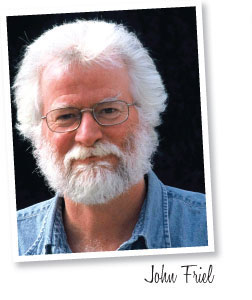1/1/2021
Back From the Future II
John Friel

Once again, This Space is trying to divine the mojo of a post-deadline industry event: Virtual MANTS, which is about to launch as you read.
What have we learned from virtual industry experiences so far? It says here, we’ve learned that virtual works very well for the education side, not well at all for the marketing/networking component.
It feels somewhat disloyal to write that and I hope MANTS proves me wrong. We all want a trade show surrogate that feels like we’re there. But no one’s managed (yet) to replicate the immersive experience and camaraderie of a real trade show. Kudos, however, to AmericanHort for breaking new ground and trying to bring something like Cultivate to life on our screens last summer. And I’ll be “at” MANTS, too.
Enough pessimism. Let’s look at a successful educational event. The Perennial Plant Association is exploring many facets of this format, most recently with November’s panel presentation, “The Grass Toolbox.”
Panelists included Mike Berkley of GroWild, Inc., a native nursery in Tennessee; Laura Ekasetya, Director of Lurie Garden, Chicago; and Donald Pell, high-end landscape designer near Philadelphia.
I’m not big on panel discussions, but this worked. And it focused on grasses, a topic near and dear to my heart and wallet. Among the questions posed by the invisible audience was this stumper: What’s the correct ratio of grasses vs. other elements in a well-designed garden? Crickets.
Finally, Donald said, “I don’t think there is one.” His designs sometimes feature 50% grasses because they put on such a long show. “I love flowers too,” he said, “But they’re ephemeral. Grasses are the backbone of the garden. I don’t understand gardens without grasses.” Music to the ears of a guy whose employer farms grasses like row crops and ships them throughout North America.
Donald praised Eragrostis spectabilis, “love grass,” as “a great understory layer,” and called carex varieties “workhorses.” Yes, they’re sedges, not true grasses, but they look, work and sell like grasses. Mike noted that there are over 300 native sedges east of the Mississippi River.
Indigenous plants have taken their rightful place as respected elements in well-designed gardens. The native plant movement started as niche, a cause, but gradually American growers realized that if we had good selections, we were already halfway to being native plant growers because so many perennials with European names originated in the New World.
Native grasses followed, but some now come with the sort of warning labels generally applied to imports. Take Chasmanthium. Laura loves it, but cautioned, “be careful where you use it”—i.e., don’t plant it in windy areas or seed scatters. She didn’t say where in Chicago, exactly, is a non-windy area, but Lurie is a big garden. She must have found one.
Climate change reared its ugly head. Mike said Nassella didn’t overwinter in Tennessee until recently. Now it spreads because “the South is getting hotter. We don’t get freezes anymore, it’s just wet.”
Mike mentioned an interesting native with an unfortunate name: Diarrhena americana. Noted plantsman Allen Bush first showed it to me in Minnesota. I thought he was kidding. He wasn’t. It’s a sturdy little grower that tolerates dry shade, but it will never live down that awful name. It’s the Boy Named Sue of grasses.
One native got nods all around: Schizachyrium Standing Ovation, a Pennsylvania discovery. “It’s the bomb,” said Mike.
Maybe in some brave new world when everyone has virtual reality headgear, online trade shows will be more like the real thing. Meanwhile, AmericanHort, PPA and others have more educational presentations planned. Zoom on in. GP
John Friel is marketing manager for Emerald Coast Growers and a freelance writer.